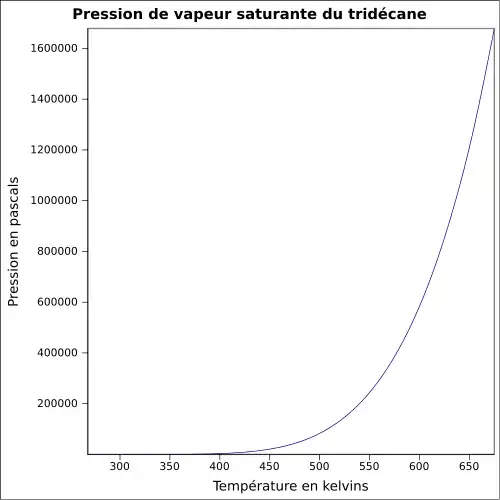Tridécane
Le tridécane est un alcane linéaire de formule brute C13H28. Il possède 802 isomères structuraux.
| Tridécane | ||
| Représentations du tridécane | ||
| Identification | ||
|---|---|---|
| Nom UICPA | tridécane | |
| Synonymes |
n-tridécane |
|
| No CAS | ||
| No ECHA | 100.010.086 | |
| No CE | 211-093-4 | |
| PubChem | 12388 | |
| SMILES | ||
| InChI | ||
| Apparence | Liquide incolore | |
| Propriétés chimiques | ||
| Formule | C13H28 [Isomères] |
|
| Masse molaire[1] | 184,361 4 ± 0,012 4 g/mol C 84,69 %, H 15,31 %, |
|
| Propriétés physiques | ||
| T° fusion | −5,15 °C[2] | |
| T° ébullition | 233,85 °C[2] | |
| Masse volumique | 0,752 8 g·cm-3 à 24,95 °C [3]
|
|
| Point d’éclair | 102 °C | |
| Limites d’explosivité dans l’air | 0,6–6,5 %vol | |
| Pression de vapeur saturante | 1 mmHg (130 Pa) à 59 °C
|
|
| Viscosité dynamique | 1,649 mPa·s à 24,95 °C 1,075 mPa·s à 49,95 °C [3] |
|
| Point critique | 17,20 bar[5], 402,85 °C[2] | |
| Point triple | −5,36 °C[2] | |
| Thermochimie | ||
| S0gaz, 1 bar | 661,45 J·mol-1·K-1 [6] | |
| S0liquide, 1 bar | 522,87 J·mol-1·K-1 [7] | |
| ΔfH0gaz | −311,5 kJ·mol-1 ± 1,6 [8] | |
| ΔfH0liquide | −377,7 kJ·mol-1 ± 1,6 [8] | |
| ΔfusH° | 91,4 kJ·mol-1 [2] | |
| ΔvapH° | 66,43 kJ·mol-1 [2] | |
| Cp | 409,40 J·K-1·mol-1 à 30 °C (liquide) [9]
|
|
| Précautions | ||
| SIMDUT[11] | ||
 B3, |
||
| Directive 67/548/EEC | ||
 Xn  F+  N |
||
| Unités du SI et CNTP, sauf indication contraire. | ||
Il se présente sous la forme d'un liquide incolore et est utilisé dans l'industrie papetière et dans celle du caoutchouc mais également comme combustible ou comme solvant.
Il est sécrété par certains insectes à des fins de défense contre les prédateurs.
Notes et références
- Masse molaire calculée d’après « Atomic weights of the elements 2007 », sur www.chem.qmul.ac.uk.
- (en) « Tridécane », sur NIST/WebBook
- (en) Makio Iwahashi, Yoshimi Yamaguchi, Yoshio Ogura et Masao Suzuki, « Dynamical Structures of Normal Alkanes, Alcohols, and Fatty Acids in the Liquid State as Determined by Viscosity, Self-Diffusion Coefficient, Infrared Spectra, and 13CNMR Spin-Lattice Relaxation Time Measurements », Bulletin of the Chemical Society of Japan, vol. 8, , p. 2154-2158 (DOI 10.1246/bcsj.63.2154)
- (en) Robert H. Perry et Donald W. Green, Perry's Chemical Engineers' Handbook, USA, McGraw-Hill, , 7e éd., 2400 p. (ISBN 0-07-049841-5), p. 2-50
- Teja, A.S.; Lee, R.J.; Rosenthal, D.J.; Anselme, M.J., Correlation of the Critical Properties of Alkanes and Alkanols in 5th IUPAC Conference on Alkanes and AlkanolsGradisca, 1989.
- Stull D.R., Jr., The Chemical Thermodynamics of Organic Compounds. Wiley, New York, 1969.
- Finke, H.L.; Gross, M.E.; Waddington, G.; Huffman, H.M.,Low-temperature thermal data for the nine normal paraffin hydrocarbons from octane to hexadecane, J. Am. Chem. Soc., 1954, 76, 333-341.
- Prosen, E.J.; Rossini, F.D., Heats of combustion and formation of the paraffin hydrocarbons at 25 °C, J. Res. NBS, 1945, 263-267.
- Woycicka, M.K.; Kalinowska, B., Enthalpies of mixing and excess heat capacities of dilute solutions of n-decanol with n-heptane and n-tridecane, Bull. Acad. Pol. Sci., Ser. Sci. Chim., 1975, 23, 759-764.
- (en) Carl L. Yaws, Handbook of Thermodynamic Diagrams : Organic Compounds C8 to C28, vol. 3, Huston, Texas, Gulf Pub. Co., , 396 p. (ISBN 0-88415-859-4)
- « Tridécane » dans la base de données de produits chimiques Reptox de la CSST (organisme québécois responsable de la sécurité et de la santé au travail), consulté le 25 avril 2009
- Portail de la chimie
Cet article est issu de Wikipedia. Le texte est sous licence Creative Commons - Attribution - Partage dans les Mêmes. Des conditions supplémentaires peuvent s'appliquer aux fichiers multimédias.


